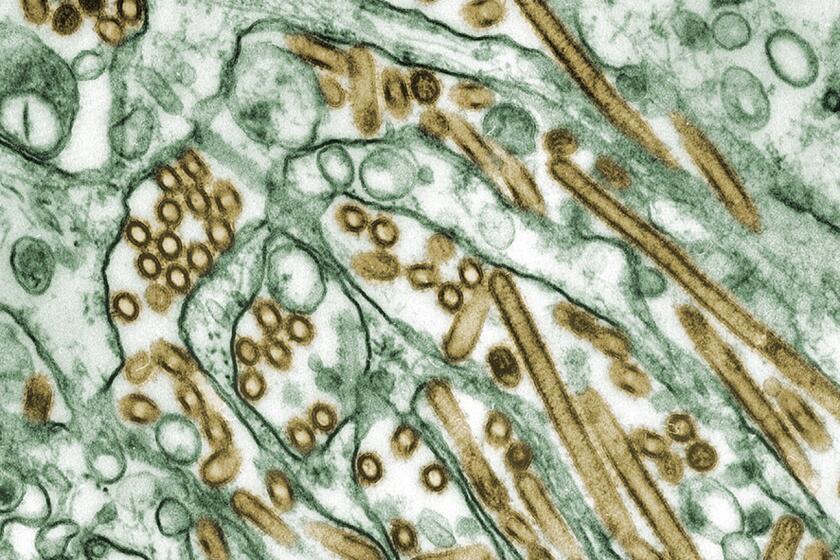British Beef Shunned Amid Disease Fears
Consumers at home and abroad revolted against British beef Thursday after the British government conceded that there may be a link between what is known as “mad cow disease” and the deaths of 10 people from an incurable brain disorder.
The government denied that there is any cause for alarm but said the entire national herd of 11 million cattle could be slaughtered if scientists advise it.
In a move Agriculture Minister Douglas Hogg called “unreasonable, unnecessary and probably illegal,” France, Belgium and five German states banned imports of British beef. In Brussels, British scientists conferred with worried European Union officials.
Across Britain, school boards announced they would scrap beef from lunch menus, joining an estimated one-third of British schools that were already beefless.
It was burgers as usual at fast-food restaurants in downtown London on Thursday night, but cattle prices slumped 15%, food-processing companies lost ground on the stock market, and crisis gripped the $6-billion-a-year cattle industry. Nearly half of all British farmers have some cattle.
Mad-cow alarm has been a regular visitor to Britain for a decade: Cattle began dying of bovine spongiform encephalopathy (BSE) in 1985. The disease in cattle has been traced to infected sheep offal in cattle feed. The sale of offal, including spinal cords and brains, was banned in 1989.
Over the past decade, the British government rebutted concerns with repeated assurances that there was no possibility the disease could jump the species barrier from cattle to humans. On Wednesday, though, Health Minister Stephen Dorrell said scientists had found a likely link between BSE and its human equivalent, incurable Creutzfeldt-Jakob disease (CJD).
Scientists in Scotland recently found a new strain of CJD in 10 cases among fatally stricken teenagers and young adults. They theorize that the victims may have been infected by beef they ate during the first stage of the BSE epidemic, 1986-89.
Dorrell stunned the nation when he told Parliament: “There remains no scientific proof that BSE can be transmitted to man by beef, but the [scientific advisory] committee has concluded that the most likely explanation at present is that these [10] cases are linked to exposure to BSE before the introduction of the specific bovine offal ban in 1989.”
The government sought to short-circuit public alarm: “The risks associated with eating beef and beef products are extremely low,” Dorrell told the BBC on Thursday.
The government says that the 1989 safeguards mean there is no current risk. The chance of contracting CJD is literally “one in a million” in any given year, by the official estimate.
Not everybody likes those odds.
The absence of scientific evidence does not convince Dr. Will Patterson, a public health doctor in North Yorkshire, where a man died recently of the new strain of CJD. “There is a strong argument that BSE is guilty until proven innocent,” Patterson said Thursday.
The Birmingham City Council and the Berkshire, Bedfordshire, Cheshire and Clwyd county councils on Thursday joined a swelling ban on beef at school.
Cleveland County chief executive Bruce Stevenson said there had been tight controls on beef in local schools since 1990. “However . . . in light of the latest developments, it is only sensible to remove beef from all school menus,” he said.
The new findings follow studies of the 10 young people who died from the degenerative brain disease, which can take more than 10 years after infection to reveal itself.
CJD among young people rose from 18 cases in 1990 to 56 cases in 1994 in a country of 58 million, the government said. Robert Will, head of the government’s CJD unit in Edinburgh, Scotland, said the average age of the 10 victims was 27.5 years, compared to 63 years in previous cases.
“Is there a particular risk for beef eating among small children? That is a precise question to which we have not yet received a precise answer,” Dorrell said, to the alarm of parents, doctors, consumers and farmers.
Both BSE and CJD cause holes in brain tissues, giving the brain a spongelike appearance. The diseases cause dementia, aggression, disorientation, lack of coordination and, finally, death.
The first case in the British Isles was reported in 1985, when a Holstein dairy cow suddenly became edgy and uncoordinated, then aggressive and unpredictable.
In 1986, the disease was given its BSE name, and by 1988 more than 700 cases had been reported in Britain. By now, about 160,000 infected cattle have been slaughtered and burned.
Scientists note that the disease resembles a sheep disease called scrapie. How BSE jumped to cows is still not clear, but the culprit is suspected to have been an infectious protein called a prion. It is thought to have crossed to cows from parts of scrapie-infected sheep processed as part of protein-enriched cattle feed.
Despite the species jump from sheep to cow, the government repeatedly denied that there was any risk to humans. In 1989, a government report said “it is most unlikely that BSE will have any implications for human health.”
The denials continued unabated over the years--amid new spikes in public alarm--as other species were found to have been infected in small numbers at zoos, farms and game parks: elk, mice, cheetahs, pigs, domestic cats.
In 1990, the special watchdog unit was established in Edinburgh to monitor any possible link between BSE and CJD.
More to Read
Start your day right
Sign up for Essential California for news, features and recommendations from the L.A. Times and beyond in your inbox six days a week.
You may occasionally receive promotional content from the Los Angeles Times.






